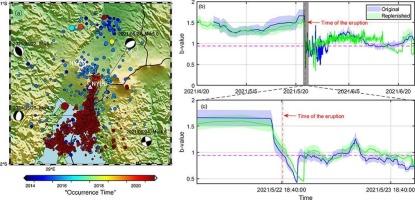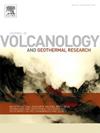What Triggered the 2021 eruption at Nyiragongo volcano (D.R. Congo)? Unraveling the Complex Interplay between tectonism and magmatism
IF 2.3
3区 地球科学
Q2 GEOSCIENCES, MULTIDISCIPLINARY
Journal of Volcanology and Geothermal Research
Pub Date : 2025-08-14
DOI:10.1016/j.jvolgeores.2025.108429
引用次数: 0
Abstract
After a 20-year repose, Nyiragongo volcano in the eastern Democratic Republic of the Congo experienced a flank eruption on May 22, 2021, claiming over 30 lives and causing substantial economic loss. Despite extensive studies, the eruption's triggering mechanism remains unclear. In this study, we analyze earthquakes beneath the volcano's summit to examine the b-value variations in the Gutenberg–Richter law, which reflects the ratio of small to large earthquakes and inversely correlates with differential stress. Our goal is to track magma system dynamics leading to the eruption and identify its catalyst. We observe notable differences in b-value estimates during the pre- and syn-eruptive phases. First, the b-value consistently increases over 20 % above the background level ( = 0.94) for a few days, peaking at 1.55 two days before the eruption, then drops to 59 % below the during the eruption. In the six hours following the eruption, b-values fluctuate around 90 % of the . These elevated b-values likely reflect the activation of small cracks from the influx of magma in the vicinity of the volcano. Additionally, Coulomb stress changes calculated by combining the epidemic-type aftershock sequence (ETAS) model with the rate-and-state model reveal a stress increase of approximately 10.5 MPa just before the eruption. To address the issue of missing events caused by seismic network density incompleteness and short-term aftershock incompleteness, we created a replenished catalog. Analyzing this catalog, we successfully reproduced b-values, demonstrating its reliability for analyzing volcanic seismicity in regions with sparse networks. Our findings underscore the importance of incorporating systematic b-value time series analysis into regular volcano monitoring programs to improve forecasting capability.

是什么引发了2021年尼拉贡戈火山(刚果民主共和国)的喷发?揭示构造和岩浆作用之间复杂的相互作用
在沉寂了20年之后,位于刚果民主共和国东部的尼拉贡戈火山于2021年5月22日发生侧翼喷发,造成30多人死亡,并造成重大经济损失。尽管进行了广泛的研究,但火山喷发的触发机制仍不清楚。在本研究中,我们分析了火山峰顶下的地震,以检验古腾堡-里希特定律中的b值变化,该定律反映了小地震与大地震的比例,并与差应力呈负相关。我们的目标是追踪导致火山喷发的岩浆系统动力学,并确定其催化剂。我们观察到在爆发前和爆发同步阶段的b值估计有显著差异。首先,b值连续几天高于背景水平(bref = 0.94) 20%以上,在喷发前两天达到峰值1.55,然后在喷发期间降至低于bref的59%。在喷发后的6个小时内,b值在90%的时间内波动。这些升高的b值可能反映了火山附近岩浆流入引起的小裂缝的激活。此外,结合流行型余震序列(ETAS)模型和速率-状态模型计算的库仑应力变化表明,在火山爆发前,库仑应力增加了约10.5 MPa。为了解决由于地震台网密度不完整和短期余震不完整造成的缺失事件问题,我们创建了一个补充目录。通过分析该目录,我们成功地再现了b值,证明了其在稀疏网络地区分析火山地震活动的可靠性。我们的发现强调了将系统的b值时间序列分析纳入常规火山监测程序以提高预测能力的重要性。
本文章由计算机程序翻译,如有差异,请以英文原文为准。
求助全文
约1分钟内获得全文
求助全文
来源期刊
CiteScore
5.90
自引率
13.80%
发文量
183
审稿时长
19.7 weeks
期刊介绍:
An international research journal with focus on volcanic and geothermal processes and their impact on the environment and society.
Submission of papers covering the following aspects of volcanology and geothermal research are encouraged:
(1) Geological aspects of volcanic systems: volcano stratigraphy, structure and tectonic influence; eruptive history; evolution of volcanic landforms; eruption style and progress; dispersal patterns of lava and ash; analysis of real-time eruption observations.
(2) Geochemical and petrological aspects of volcanic rocks: magma genesis and evolution; crystallization; volatile compositions, solubility, and degassing; volcanic petrography and textural analysis.
(3) Hydrology, geochemistry and measurement of volcanic and hydrothermal fluids: volcanic gas emissions; fumaroles and springs; crater lakes; hydrothermal mineralization.
(4) Geophysical aspects of volcanic systems: physical properties of volcanic rocks and magmas; heat flow studies; volcano seismology, geodesy and remote sensing.
(5) Computational modeling and experimental simulation of magmatic and hydrothermal processes: eruption dynamics; magma transport and storage; plume dynamics and ash dispersal; lava flow dynamics; hydrothermal fluid flow; thermodynamics of aqueous fluids and melts.
(6) Volcano hazard and risk research: hazard zonation methodology, development of forecasting tools; assessment techniques for vulnerability and impact.

 求助内容:
求助内容: 应助结果提醒方式:
应助结果提醒方式:


